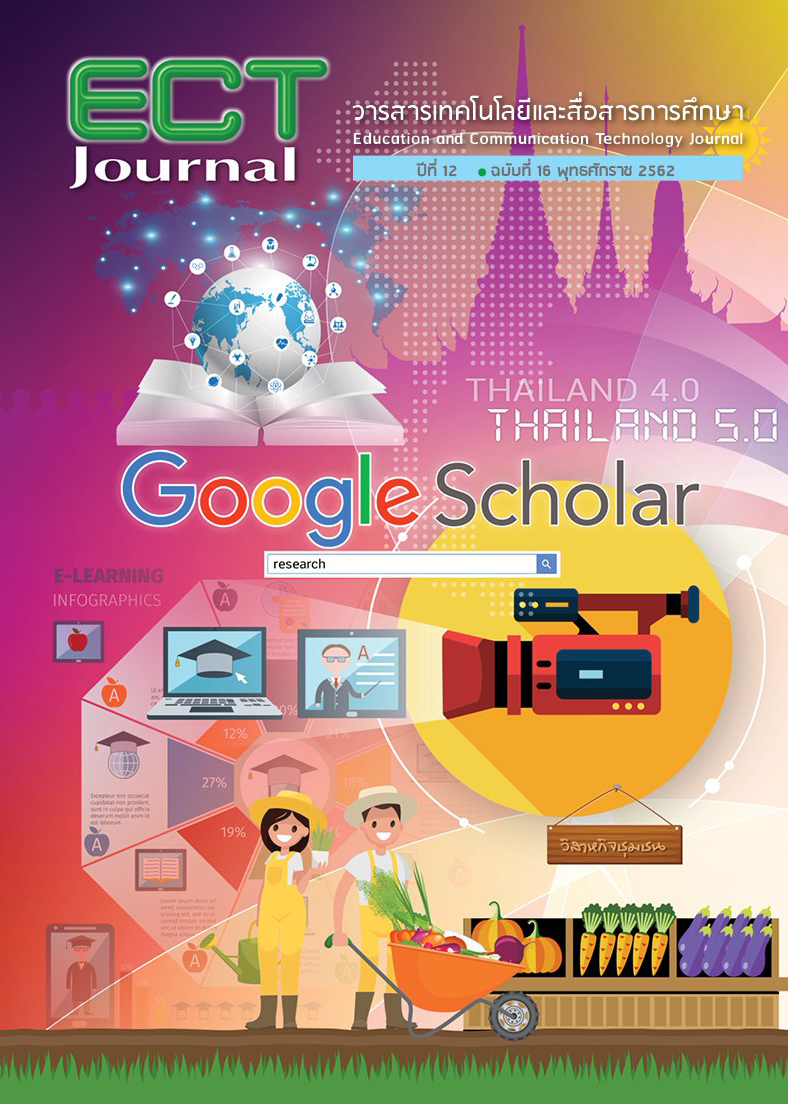Planning of Video Production in Digital Age
Keywords:
Planning Video Production, Instructional video, digital ageAbstract
This article aims to present the process of planning of Video Production in the digital age. Because video is an important medium and has a greater role in teaching and learning. Including most students choose to use learning by watching videos, Therefore, the instructor should have
a plan to produce the instructional video. Due to the importance of video production, it is like defining the direction of work for oneself and the team by planning the production of instructional video in the digital age. There are 10 steps which are (1) Content analysis (2) Write the objectives of instructional videos (3) Determine video presentation formats, Types of programs, Program schedule, Video length (4) Learner analysis (5) Video presentation analyze (6) Design activity of video based learning (7) Determine how to use the video (8) Determine the location for the production of instructional video (9) Determine the responsible person / The equipment used for the shoot (10) Determine Budget
References
ทิพย์เกสร บุณอำไพ. (2540). หน่วยที่ 7 การผลิตรายการโทรทัศน์เพื่อการศึกษา. เอกสารประกอบการสอนชุดวิชา วิทยุกระจายเสียงและวิทยุโทรทัศน์เพื่อการศึกษา. สาขาวิชาศึกษาศาสตร์. นนทบุรี: สำนักพิมพ์มหาวิทยาลัยสุโขทัยธรรมาธิราช.
ทิพย์เกสร บุณอำไพ. (2560). หน่วยที่ 8 การผลิตรายการโทรทัศน์เพื่อการศึกษา. เอกสารประกอบการสอนชุดวิชา วิทยุกระจายเสียงและวิทยุโทรทัศน์เพื่อการศึกษา. สาขาวิชาศึกษาศาสตร์. นนทบุรี: สำนักพิมพ์มหาวิทยาลัยสุโขทัยธรรมาธิราช.
นรินธน์ นนทมาลย์. (2560). การพัฒนารูปแบบการออกแบบการสอนแบบเปิดด้วยวิธีการคิดอย่างเป็นระบบและกระบวนการกลุ่มโดยใช้วิดีโอเป็นฐาน เพื่อพัฒนาความสามารถในการแก้ปัญหาเชิงสร้างสรรค์ของผู้เรียนระดับอุดมศึกษา. (ปริญญาครุศาสตรดุษฎีบัณฑิต), จุฬาลงกรณ์มหาวิทยาลัย, กรุงเทพมหานคร.
นรินธน์ นนทมาลย์. (2561). รูปแบบการผลิตวิดีโอออนดีมานด์เพื่อการเรียนรู้ในการเรียนทางไกลแบบเปิด. วารสารสารเทคโนโลยีและสื่อสารการศึกษา (ETC Journal). 13(14-15).
วรางคณา โตโพธิ์ไทย. (2560). หน่วยที่ 7 สามัญเกี่ยวกับวิทยุโทรทัศน์เพื่อการศึกษา. เอกสารประกอบการสอนชุดวิชา วิทยุกระจายเสียงและวิทยุโทรทัศน์เพื่อการศึกษา. นนทบุรี: สำนักพิมพ์มหาวิทยาลัยสุโขทัยธรรมาธิราช.
วสันต์ อติศัพท์. (2528). การผลิตเทปโทรทัศน์เพื่อการศึกษา: ภาควิชาเทคโนโลยีการศึกษา คณะศึกษาศาสตร์ มหาวิทยาลัยสงขลานครินทร์ วิทยาเขตปัตตานี.
วาสนา ทวีกุลทรัพย์. (2540). หย่วยที่ 5 การผลิตรายการวิทยุเพื่อการศึกษา. เอกสารประกอบการสอนชุดวิชา วิทยุกระจายเสียงและวิทยุโทรทัศน์เพื่อการศึกษา. สาขาวิชาศึกษาศาสตร์. นนทบุรี: สำนักพิมพ์มหาวิทยาลัยสุโขทัยธรรมาธิราช.
วิรุฬห์ ลีลาพฤทธิ์. (2529). การวางแผนโทรทัศน์การศึกษา. กรุงเทพมหานคร: คณะครุศาสตร์ จุฬาลงกรณ์มหาวิทยาลัย.
สมเชาว์ เนตรประเสริฐ. (2540). หน่วยที่ 6 วิทยุโทรทัศน์เพื่อการศึกษา. เอกสารประกอบการสอนชุดวิชา วิทยุกระจายเสียงและวิทยุโทรทัศน์เพื่อการศึกษา. สาขาวิชาศึกษาศาสตร์. นนทบุรี: สำนักพิมพ์มหาวิทยาลัยสุโขทัยธรรมาธิราช.
สำนักงานคณะกรรมการกิจการกระจายเสียง กิจการโทรทัศน์ และกิจการโทรคมนาคมแห่งชาติ. (2562). คาดการณ์จำนวนผู้ชมทีวีออนไลน์ OTT เปรียบเทียบสภาพตลาดโลกและ OTT ไทย (2019-2023). Retrieved from https://broadcast.nbtc.go.th/data/academic/file/620800000002.pdf.
สำนักงานพัฒนาธุรกรรมทางอิเล็กทรอนิกส์ (องค์การมหาชน) กระทรวงดิจิทัลเพื่อเศรษฐกิจและสังคม. (2562). รายงานผลการสำรวจพฤติกรรมผู้ใช้อินเทอร์เน็ตในประเทศไทย ปี 2561 Thailand Internet User Profile 2018. กรุงเทพมหานคร.
Bevan, M. (2019). Why Videos are Important in Education. Retrieved from https://www.nextthoughtstudios.com/video-production-blog/2017/1/31/why-videos-are-important-in-education
Bloom, B. S. (1956). Taxonomy of educational objectives. Vol. 1: Cognitive domain. New York: McKay, 20-24.
Cartwright, S. (2012). Pre-production planning for video, film, and multimedia: Routledge.
Chi, C. (2018). How Long Should Your Videos Be? Ideal Lengths for Facebook, Instagram, Twitter, and YouTube [Infographic]. Retrieved from https://blog.hubspot.com/marketing/how-long-should-videos-be-on-instagram-twitter-facebook-youtube
Clarine, B. (2016). 11 Reasons Why Video is Better Than Any Other Medium. Retrieved from https://www.advancedwebranking.com/blog/11-reasons-why-video-is-better/
Compesi, R., & Gomez, J. (2015). Introduction to video production: Studio, field, and beyond: Routledge.
Dale, E. (1969). Audiovisual methods in teaching.
Denning, D. (2015). Video in Theory and Practice: Issues for Classroom Use and Teacher Video Evaluation. Department of Social and Natural Sciences. Faculty of Education, University of Victoria,
Diamond, R. M. (1964). A GUIDE TO INSTRUCTIONAL TELEVISION.
Gross, L. S., Foust, J. C., & Burrows, T. D. (2005). Video production: disciplines and techniques: McGraw-Hill Boston.
Gustafson, K. L., & Branch, R. M. (2002). What is instructional design. Trends and issues in instructional design and technology, 16-25.
Köster, J. (2018). Video in the Age of Digital Learning. Cham: Springer.
Krathwohl, D. R. (2002). A revision of Bloom's taxonomy: An overview. Theory into practice, 41(4), 212-218.
Lewis, R. (1993). Learn to Video in a Weekend (Learn in a Weekend) London: Dorling Kindersley Publishers Ltd.
Lynch, L. (2019). How Long Should Videos Be for E-Learning? Retrieved from https://www.learndash.com/how-long-should-videos-be-for-e-learning/
MacMaster, K. (2019). Top 10 Reasons You Need Video in Your Content Marketing Plan. Retrieved from https://www.vidyard.com/blog/importance-of-video-content-marketing/
Millerson, G. (1994). Effective TV production: Routledge.
Millerson, G., & Owens, J. (2012). Television production: Routledge.
Moore, D., Bates, A., & Grundling, J. (2002). Instructional design. Skills Development through Distance Education, 71.
Morrison, G. R., Ross, S. M., Kemp, J. E., & Kalman, H. (2010). Designing effective instruction: John Wiley & Sons.
O'Donoghue, M. (2013). Producing video for teaching and learning: Planning and collaboration: Routledge.
O”Riordan, T. (2012). Video Production Workflow. Retrieved from http://www.jisc.ac.uk/~/media/195B9F6D012346328DD8EEC7239781BD.ashx
Owens, J. (2017). Video production handbook: Routledge.
Pandey, A. (2019). 6 Must-Use Video-Based Learning Strategies In 2019. Retrieved from https://elearningindustry.com/video-based-learning-strategies-2019
Richey, R. C., Klein, J. D., & Tracey, M. W. (2010). The instructional design knowledge base: Theory, research, and practice: Routledge.
Riordan, T. O. (2012). Video Production Workflow. Retrieved from http://www.jisc.ac.uk/~/media/195B9F6D012346328DD8EEC7239781BD.ashx
Seels, B., & Glasgow, Z. (1990). Exercises in instructional design. Merrill Publishing Company.
Shift disruptive elearning. (2019). 9 Ways to Use Video in Your Online Training Courses. Retrieved from https://www.shiftelearning.com/blog/9-ways-to-use-video-in-your-online-training-courses
Simon, J. (2019). Why Video is Important: What You Need to Know. Retrieved from https://www.techsmith.com/blog/why-video-is-important/
Welbourne, D. J., & Grant, W. J. (2016). Science communication on YouTube: Factors that affect channel and video popularity. Public Understanding of Science, 25(6), 706-718.
Westenberg, W. (2016). The influence of YouTubers on teenagers: a descriptive research about the role YouTubers play in the life of their teenage viewers. University of Twente,
Zettl, H. (2012). Video basics: Cengage Learning.
Downloads
Published
How to Cite
Issue
Section
License
1. ทรรศนะและข้อคิดเห็นใด ๆ ที่ปรากฏอยู่ในวารสาร ECT Education and Communication Technology Journal เป็นของผู้เขียนโดยเฉพาะ สำนักเทคโนโลยีการศึกษา มหาวิทยาลัยสุโขทัยธรรมาธิราช และกองบรรณาธิการไม่จำเป็นต้องเห็นพ้องด้วย
2. กองบรรณาธิการของสงวนลิขสิทธิ์ในการบรรณาธิการข้อเขียนทุกชิ้น เพื่อความเหมาะสมในการจัดพิมพ์เผยแพร่






